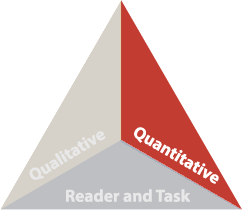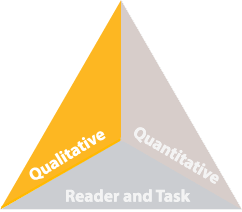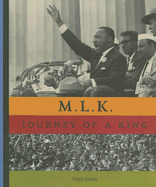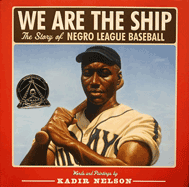Collection Analysis Report
for Nonfiction, 6-8
This report provides data analyses into the titles on this list to help support your efforts to put the right book in each reader's hands.
This report is organized by Collection Analysis by Genre, Cultural, and Curricular Areas, Quantitative Measures, and Qualitative Measures.
Explore all of TeachingBooks
Sign in and enjoy.
Collection Analysis by Genre, Cultural, and Curricular Areas
For the 15 books on this list, please find an analysis revealing the quantity of titles associated with genre, cultural, and curriculum classifications. Additionally, please find the "Not Represented" section where you can click to identify other titles to potentially add to this list.
We hope this collection analysis tool helps you achieve the variety and differentiation of books that you want for your reading opportunities.
(15 of 15 titles have genres, curricular, or cultural experiences.)
- Nonfiction (14 books)
- Biography (10 books)
- History (10 books)
- Social Studies (7 books)
- Science (6 books)
- English Language Arts (3 books)
- STEAM (3 books)
- Graphic Novel (2 books)
- Picture Book (2 books)
- Adventure (1 books)
- Art (1 books)
- Physical Education (1 books)
- Sports (1 books)
Genre, Curricular, and Cultural Experience categories are assigned by TeachingBooks based on professional reviews, authoritative sources, and company guidelines.
 Quantitative Measures
Quantitative Measures
For 13 of 15 titles that have known Lexile levels, below is the low, high, and average Lexile® for the books in this list. We hope these data points, along with the crosswalk to other measures, provide insights into the variety and differentiation of this collection.
Lexile® Average: 949 (Range: 410 - 1210)
Reading Level and Grade Band Crosswalk
| Grade Band | Lexile® | ATOS | Degrees of Reading Power® | Flesch-Kincaid | Fountas & Pinnell | Reading Maturity | SourceRater |
|---|---|---|---|---|---|---|---|
| 2-3 | 420-820 | 2.75-5.14 | 42-54 | 1.98-5.34 | I-P | 3.53-613 | 0.05-2.48 |
| 4-5 | 740-1010 | 4.97-7.03 | 52-60 | 4.51-7.72 | O-V | 5.42-7.92 | 0.84-5.75 |
| 6-8 | 925-1185 | 7.00-9.98 | 57-67 | 6.51-10.34 | U-Z | 7.04-9.57 | 4.11-10.66 |
| 9-10 | 1050-1335 | 9.67-12.01 | 62-72 | 8.32-12.12 | Z+ | 8.41-10.81 | 9.02-13.93 |
| 11-12 | 1185-1385 | 11.20-14.10 | 67-74 | 10.34-14.20 | Z+ | 9.57-12.00 | 12.30-14.50 |
Key: Purple highlight represents average.
Source: National Governors Association for Best Practices and Council of Chief State School Officers.[1]
 Qualitative Measures (BETA)
Qualitative Measures (BETA)
For 6 of 15 titles that have known qualitative measurements, this graph reveals the aggregated low, high, and average qualitative measures for the books in this list. We hope this range of information shows the variety and differentiation of this collection.
Qualitative Text Complexity Ranges
= low and high range of submitted values = average of submitted values
- Slightly
- Moderately
- Very
- Exceedingly
Qualitative measures for each title are determined by crowd sourced results from professional educators who complete the literary or informational text complexity rubrics. These are relatively new on TeachingBooks so only a small percentage of all the titles have currently been evaluated. Perhaps you can help?
Instructional Materials Summary
Below please find a summary of available multimedia texts and instructional materials that enrich and deepen the discussion of the titles on this list.
- 20 Videos
- 16 Book Readings
- 27 Lesson Plans
- Total of 302 resources
Details for Each Book
Below are the titles on Cooperative Children's Book Center (CCBC)'s "Nonfiction, 6-8". If you wish to see the curricular areas, genres, Lexile® and Qualitative measures, along with the collection of ready-to-use instructional materials, go online to TeachingBooks at: https://school.teachingbooks.net/QLAJP7M
Almost Astronauts: 13 Women Who Dared to Dream
- Genres: Biography, Nonfiction
- Cultural Experiences: Gender, Women / Girls
- Curricular Areas: History, Science, STEAM
- Lexile: 980
- Year Published: 2009
Amelia Lost: The Life and Disappearance of Amelia Earhart
- Grades Used: 7
- Genres: Biography, Nonfiction
- Curricular Areas: History, Science
- Lexile: 930
- Year Published: 2011
Qualitative Measures:
- Meaning: Moderately Complex
- Text Organization: Very Complex
- Use of Visual Features: Moderately Complex
- Conventionality: Very Complex
- Vocabulary: Moderately Complex
- Sentence Structure: Very Complex
- Subject Matter Knowledge: Moderately Complex
- Intertextuality: Moderately Complex
Comic Book Century: The History of American Comic Books
- Genres: Graphic Novel
- Curricular Areas: English Language Arts
- Lexile: Unknown
- Year Published: 2007
The Frog Scientist
by Pamela S. Turner and Andy Comins Pamela S. Turner and Andy Comins
Part of the Scientists in the Field Series
- Genres: Nonfiction
- Curricular Areas: Science
- Lexile: 950
- Year Published: 2009
George Washington, Spymaster: How the Americans Outspied the British and Won the Revolutionary War
- Genres: Biography, Nonfiction
- Curricular Areas: History
- Lexile: 1100
- Year Published: 2004
Getting Away with Murder: The True Story of the Emmett Till Case
by Chris Crowe
- Grades Used: 6, 7, 8
- Genres: Biography, Nonfiction
- Cultural Experiences: African (Global), African American
- Curricular Areas: History, Social Studies
- Lexile: 1210
- Year Published: 2003
Qualitative Measures:
- Meaning: Moderately Complex
- Text Organization: Slightly Complex
- Use of Visual Features: Slightly Complex
- Conventionality: Very Complex
- Vocabulary: Very Complex
- Sentence Structure: Very Complex
- Subject Matter Knowledge: Exceedingly Complex
- Intertextuality: Exceedingly Complex
How to Survive in Antarctica
- Genres: Adventure, Biography, Nonfiction
- Curricular Areas: Science
- Lexile: Unknown
- Year Published: 2006
M.L.K.: The Journey of a King
by Tonya Bolden
- Genres: Biography, Nonfiction
- Cultural Experiences: African (Global), African American
- Curricular Areas: History, Social Studies
- Lexile: 970
- Year Published: 2007
Qualitative Measures:
View all instructional resources and text complexity results for M.L.K.Moonbird: A Year on the Wind with the Great Survivor B95
- Genres: Nonfiction
- Curricular Areas: English Language Arts, Science, Social Studies, STEAM
- Lexile: 1150
- Year Published: 2012
Qualitative Measures:
View all instructional resources and text complexity results for MoonbirdPresenting Buffalo Bill: The Man Who Invented the Wild West
- Genres: Biography, Nonfiction
- Curricular Areas: History, Social Studies
- Lexile: 900
- Year Published: 2016
Smile
- Grades Used: 4, 5, 6, 7, 8
- Genres: Biography, Nonfiction, Graphic Novel
- Curricular Areas: English Language Arts
- Lexile: 410
- Year Published: 2010
Qualitative Measures:
- Meaning: Moderately Complex
- Text Organization: Slightly Complex
- Use of Visual Features: Moderately Complex
- Conventionality: Moderately Complex
- Vocabulary: Moderately Complex
- Sentence Structure: Moderately Complex
- Subject Matter Knowledge: Moderately Complex
- Intertextuality: Moderately Complex
Team Moon: How 400,000 People Landed Apollo 11 on the Moon
- Genres: Nonfiction
- Curricular Areas: History, Science, STEAM
- Lexile: 1060
- Year Published: 2006
Qualitative Measures:
View all instructional resources and text complexity results for Team MoonThe Wall: Growing Up Behind the Iron Curtain
by Peter Sís
- Grades Used: 5, 7, 8, 9, 10
- Genres: Biography, Nonfiction, Picture Book
- Curricular Areas: Art, History, Social Studies
- Lexile: 760
- Year Published: 2007
Qualitative Measures:
- Meaning: Very Complex
- Text Organization: Moderately Complex
- Use of Visual Features: Exceedingly Complex
- Conventionality: Moderately Complex
- Vocabulary: Moderately Complex
- Sentence Structure: Moderately Complex
- Subject Matter Knowledge: Very Complex
- Intertextuality: Very Complex
We Are the Ship: The Story of Negro League Baseball
by Kadir Nelson
- Grades Used: 5
- Genres: Biography, Nonfiction, Picture Book, Sports
- Cultural Experiences: African American, African (Global)
- Curricular Areas: History, Physical Education, Social Studies
- Lexile: 900
- Year Published: 2008
Qualitative Measures:
- Meaning: Moderately Complex
- Text Organization: Moderately Complex
- Use of Visual Features: Very Complex
- Conventionality: Slightly Complex
- Vocabulary: Moderately Complex
- Sentence Structure: Moderately Complex
- Subject Matter Knowledge: Moderately Complex
- Intertextuality: Moderately Complex
We've Got a Job: The 1963 Birmingham Children's March
- Grades Used: 7
- Genres: Nonfiction
- Cultural Experiences: African (Global), African American
- Curricular Areas: History, Social Studies
- Lexile: 1020
- Year Published: 2012
Qualitative Measures:
- Meaning: Very Complex
- Text Organization: Very Complex
- Use of Visual Features: Very Complex
- Conventionality: Moderately Complex
- Vocabulary: Very Complex
- Sentence Structure: Moderately Complex
- Subject Matter Knowledge: Very Complex
- Intertextuality: Exceedingly Complex
Explore all of TeachingBooks
Sign in and enjoy.

















